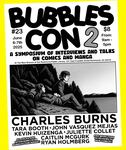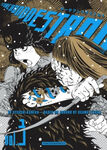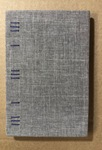
Here's a blast from the past. Perhaps serving as an example for Image in their efforts today, publisher A1 was attempting to bridge the gap between the edges and the middle of comics a decade or so ago, and while it didn't manage to publish a whole lot, what it did put out there was actually pretty much all A1. This issue revisits some of its former glory, in gearing up for the future. The feature attraction here is the complete original Bojeffries Saga episode by Alan Moore and Steve Parkhouse, but there's plenty more including, Survivor, one of the first and best comics commentaries on what Superman would "really" be like by Dave Gibbons and Ted McKeever, and Copacetic favorite: A Flaming Carrot Unsolved Mystery: The Bandit Moons, which features the first (and only?) appearance of Sponge Boy (inspiration for Sponge Bob Square Pants?). Well worth the cost of admission.

Perfect timing! Dark Horse has just published The Life and TImes of Martha Washington in the 21st Century, which collects the complete Martha Washington saga by Frank Miller and Dave Gibbons. Created over a period of twenty years starting in the late 80s with Give Me Liberty, this story is set in an early 21st century America that is splitting at the seams and headed towards civil war. Sound familiar? Now's your chance to see what today looked like from the vantage point of a quarter century (or so) back. All 560 pages of the saga are here + a 40 page scrapbook of preliminary sketches, thumbnail layouts, promo posters and more, making for a 600 page collection that's value priced.

Tired of settling for How to Draw Comics The Marvel Way when looking for something to aid and inspire an aspiring comics artist? Well then, How Comics Work might be just what you're looking for. In its 192, magazine-size, full color pages, it covers the bases from script writing, through character design, page layout, pencilling, inking, coloring, lettering, and overall book design and is unquestionably more rigorous and more in-depth and more up-to-date than How to Draw Comics The Marvel Way.
And, we just came across a smamll stack in the Copacetic Archives that we're offering here at a reduced price!
Check out Frank Santoro's reveiw from TCJ!
And here's the publisher hype-up:
In Eisner Award–nominated How Comics Work, Dave Gibbons offers a class in creating comic books. Learn scriptwriting, page layouts, lettering, and more from the incredible artist behind Watchmen!
This “How It's Done” series reveals insider hints, tips, and tricks from one of the world’s greatest comic creators, all in his own words. The artist behind juggernauts like Watchmen and The Green Lantern, Dave Gibbons is here to teach you scriptwriting, page layouts, lettering, cover designs, and more, with scans of original artwork and rarely seen workings to illustrate his personal creative processes.
How Comics Work covers both Gibbons' hand-drawn and digital design techniques in depth. An early adopter of computer design in comic creation, all his lettering is digital, and he even has his own “hand-lettered” font. This is your chance to gain insight to Gibbons' digital work, from his computer coloring and 3-D modelling with Angus McKie on Give Me Liberty, to his work on The Originals using digital grey tones. You’ll learn how he layers text for editing, creates effects such as flares and neon glows, and prepares artwork for print and online.
How Comics Work is everything you need to know to get started creating great comic books.

Here's a sharp copy ( let's say, Very Fine | VF ) of the first print of the original 1987 DC trade paperback edition of The Watchmen, collecting all 12 issues of the original series for the first time.
And, hey, the price we're offering it for here is exactly the same as the retail price of the current edition!










